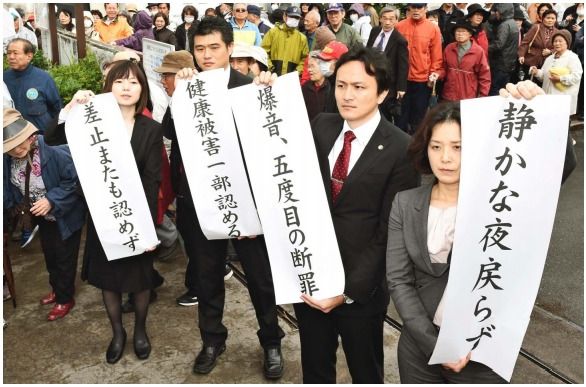In third Kadena noise lawsuit, demand for flight injunction dismissed but 30.2 billion ordered in damages

Attorneys for the plaintiffs conveying the ruling in the Kadena noise lawsuit on the morning of February 23 in front of the Okinawa branch of the Naha High Court in Okinawa City
February 24, 2017 Ryukyu Shimpo
In the third Kadena noise lawsuit, in which 22,048 residents living near U.S. Kadena Air Station demanded an injunction against nighttime and early morning flights by U.S. military aircraft and damages for past and future harm they have incurred, the Okinawa branch of the Naha District Court (judge: Tetsuya Fujikura) ruled on February 23 to recognize that the explosive noise exceeds tolerable levels and order the national government to pay the plaintiffs a total of roughly 30.2 billion yen in damages. The amount of damages exceeds that ordered in any prior base-related noise lawsuit in Japan. However, regarding the demand for an injunction against flights, Judge Fujikura stated that “[this demand] is asking the defendant [the Japanese government] to halt an act being performed by a third party [the United States] over which it has no authority,” and the court thus adopted the “third-party conduct theory”, as in previous base-related noise lawsuits, to reject the demand. The plaintiffs expressed their intention to appeal the ruling.
The monthly amount of damages ordered was higher than in any past case. Plaintiffs experiencing a “W value” (Weighted Equivalent Continuous Perceived Noise Level) of 75 or higher are to receive 7,000 yen per month, and for each increment of W5 until W90 or higher, plaintiffs will receive an additional 6,000 yen per month. Plaintiffs experiencing W95 or higher will receive 35,000 yen per month. The demand for payment of damages for harm to be incurred in the future was dismissed. Plaintiffs living north of Zamami, Yomitan Village, who were not compensated in the second Kadena noise lawsuit, were this time also recognized to be experiencing noise exceeding tolerable levels, and damages were ordered to be paid to them as well. However, damages were not ordered to be paid to plaintiffs living outside the noise distribution map (contour).
In the ruling, Judge Fujikura stated that in addition to obstruction of daily life and obstruction of sleep resulting from explosive noise, “there is also an increased risk of high blood pressure, an adverse effect on health,” thereby recognizing some of the plaintiffs’ assertions of health damage. The court did not recognize other health issues like hearing loss and an increased risk of ischemic heart disease on the grounds that evidence thereof is insufficient.
Though asserting that it is not “common damage” suffered by all the plaintiffs, the court did recognize the possibility that explosive noise could have a greater impact on children than adults, and that it could cause great distress to war survivors.
On the grounds that even after the explosive noise at Kadena was ruled unlawful in the first and second Kadena noise lawsuits, the Japanese and U.S. governments did not take fundamental damage prevention measures, the court stated, “we must assess that unlawful damage to surrounding residents is being carelessly left unaddressed.” The third Kadena noise lawsuit was initiated in April 2011. The plaintiffs numbered four times those in the second lawsuit (roughly 5,500), making it the biggest base-related noise lawsuit in Japan’s history.
(English translation by T&CT and Sandi Aritza)
Main points of the ruling:
• Demand for injunction against flights was rejected
• Amount of monthly damages:
o Areas experiencing W75 or higher: 7,000 yen
o Areas experiencing W80 or higher: 13,000 yen
o Areas experiencing W85 or higher: 19,000 yen
o Areas experiencing W90 or higher: 25,000 yen
o Areas experiencing W95 or higher: 35,000 yen
• Demand for compensation for future damages was dismissed
• Plaintiffs north of Zamami, Yomitan Village also experience damage exceeding tolerable levels
• Explosion noises increase the risk of high blood pressure
• Unlawful damage is being left unaddressed
Previous Article:1.5 trillion-yen benefit expected from return of Kadena
Next Article:Governor Onaga warns Foreign Minister pushing through Henoko base will create trouble in the future
[Similar Articles]
- In second Futenma noise lawsuit, court rejects demand for flight ban, claims of unconstitutionality
- Japanese government ordered to pay 754 million yen compensation for Futenma noise pollution
- Japanese court dismisses Kadena noise suit against U.S., citing lack of jurisdiction
- Number of plaintiffs in fourth Kadena noise lawsuit exceeds 30,000
- Japan ordered to pay 1.3 billion yen to residents around MCAS Futenma in second lawsuit
 Webcam(Kokusai Street)
Webcam(Kokusai Street)


